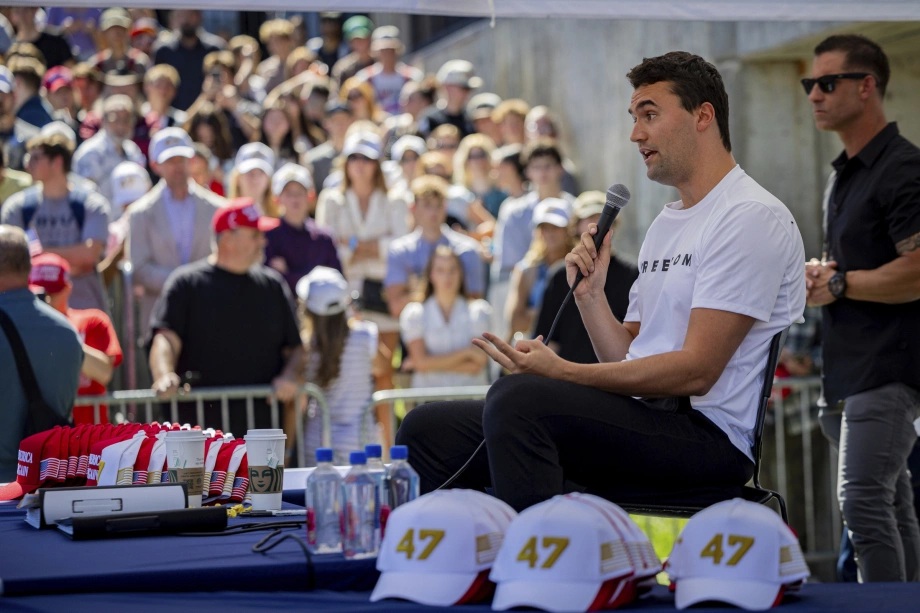Mike Tyson speaks out for the first time after the shocking passing of Charlie Kirk — Social media shaken by his heart-wrenching confession!.D
Mike Tyson speaks out for the first time after the shocking passing of Charlie Kirk — Social media shaken by his heart-wrenching confession!.D
In the wake of Charlie Kirk’s sudden passing, Mike Tyson finally broke his silence. As soon as the video of his statement spread online, social media erupted—millions of comments and countless hashtags appeared within hours.
With a trembling voice, Tyson not only shared his grief but also alluded to the darker moments of his past that sent chills down many viewers’ spines. Fans called this one of the most genuine and rare moments of the boxing legend.
Yet what shocked the public even more was not the tears—it was a surprising revelation that could forever change the way people view Charlie Kirk.
Charlie Kirk’s sudden passing sent shockwaves across the country. From social media feeds to 24-hour news channels, no one could escape the news. Millions of people woke up to the same grim headlines, their timelines flooded with tributes, disbelief, and mourning emojis. While Kirk’s name had always sparked controversy, his death brought an unexpected unity among his supporters and critics alike.
For many, it was a reminder of how fragile life could be. Headlines described the event as “shocking,” “unexpected,” and “heartbreaking,” words that felt inadequate compared to the emotional impact the news carried.
Fans flooded Twitter and Instagram, sharing clips, photos, and memories of Kirk’s public appearances. Hashtags such as #RIPCharlieKirk, #GoneTooSoon, and #CharlieForever dominated trending charts within hours.

Amid the chaos, one reaction stood out: Mike Tyson. Known for his legendary career in the boxing ring and his candid, often brutally honest public statements, Tyson’s response carried a weight no one anticipated.
In a video that quickly went viral, Tyson appeared visibly shaken. His voice, usually deep and commanding, trembled as he spoke. “I’ve fought giants in the ring, I’ve faced darkness in my own life… but hearing about Charlie’s passing humbled me,” he confessed. Tears glistened in his eyes as he recounted the shock and sorrow he felt, showing the vulnerability of a man who had conquered some of the toughest arenas in the world.
Social media erupted. Fans, celebrities, and journalists shared the video relentlessly. Within hours, it had amassed millions of views. Comments poured in: some praised Tyson’s honesty, others expressed surprise at seeing the former heavyweight champion so openly emotional. It wasn’t just a video—it was a collective catharsis for a nation grappling with sudden loss.
Tyson’s message went beyond mourning Charlie Kirk; it touched on the fragility and complexity of human experience. “He was young, fiery, and believed in something. Agree or not, he mattered,” Tyson said.
Fans who had never considered Tyson’s personal life were suddenly confronted with the man behind the gloves. They saw glimpses of his struggles with fame, addiction, and personal loss. His words about Kirk’s passing were interwoven with reflections on his own life’s shadows—moments of fear, regret, and sorrow.
For many, it was a rare, intimate moment: a champion, once feared for his ferocity in the ring, revealing the tenderness and humanity beneath his public persona.
As the video spread, social media became a frenzy. Twitter feeds were inundated with GIFs of Tyson wiping away tears, Instagram stories featured quotes from his speech, and TikTok users created short clips highlighting his most emotional moments. The hashtags were everywhere: #MikeTysonEmotional, #CharlieKirk, #GoneButNotForgotten.
Memes emerged too, some humorous but many reflective, capturing the bittersweet mix of grief and admiration. Fans debated, cried, and reminisced, turning the social media sphere into a digital vigil.
News outlets reported on the “emotional breakdown” of a man once known for his ruthless demeanor, highlighting how death and loss can touch even the strongest among us.
Tyson didn’t shy away from discussing the darker aspects of his life. He spoke of moments when fame felt hollow, when victories in the ring didn’t translate to personal fulfillment. He connected these experiences to Kirk’s untimely passing, acknowledging the unpredictable and often cruel nature of life.
“Titles, power, and fame fade—but love and memory endure,” Tyson remarked, reminding viewers that the value of life cannot be measured in accolades or public recognition. His words resonated widely, shared across platforms by people seeking comfort or perspective amidst their own personal challenges.
What made Tyson’s statement truly go viral was a single line that hinted at a revelation about Charlie Kirk. Though he didn’t fully elaborate, Tyson’s suggestion that there was more to Kirk than the public knew sparked waves of speculation.
Fans and media outlets began dissecting every word, searching for clues. Was it about Kirk’s personal life? His charitable deeds? Or a hidden struggle that few were aware of? The ambiguity created a media frenzy, and even personalities not previously engaged with Kirk’s story chimed in with their theories.
This revelation, or the hint of it, ensured that Tyson’s video remained a talking point for days. It wasn’t just grief—it was mystery, intrigue, and the human desire to uncover the full story behind someone’s life.
The aftermath of Tyson’s statement went beyond social media metrics. Conversations about legacy, mortality, and human connection flourished. People began sharing their own stories of loss, inspired by Tyson’s candidness. It sparked debates about public figures, how they are remembered, and the thin line between public persona and private reality.
Tyson’s words served as a reminder that even the most controversial figures, like Kirk, could leave meaningful impressions. And it reminded fans and critics alike that heroes, legends, and public figures are ultimately human—capable of joy, error, grief, and compassion.
Celebrities and fans alike reacted with admiration and empathy. Some former boxers praised Tyson for his honesty; media commentators noted that this was one of the rare times a public figure of Tyson’s stature had spoken so vulnerably. Ordinary fans shared screenshots of the video, expressing how they felt seen, understood, and connected through shared grief.
Even weeks later, Tyson’s video continued to trend in search queries, discussion threads, and comment sections. Analysts pointed out that while celebrity reactions to death are common, few have the authenticity and rawness that Tyson displayed.
At its heart, Tyson’s message was simple yet profound: achievements, wealth, and power are fleeting, but the love we give and the memories we leave behind endure. His reflections gave viewers a chance to pause, to consider what truly matters in life, and to appreciate the human connections that outlast fame and fortune.
Fans began sharing stories of their own loved ones lost too soon, finding solace in Tyson’s acknowledgment that grief is universal, and that tears do not diminish strength—they reveal it.
Mike Tyson’s statement about Charlie Kirk became more than a viral video; it became a cultural moment. It reminded a grieving nation that even the fiercest of champions are vulnerable. It demonstrated that emotional honesty has the power to bridge divides, spark reflection, and unite people in shared humanity.
Through grief, tears, and subtle revelation, Tyson showed that while death can shock and sadden, the legacy of a life—controversial or celebrated—lives on in memory, stories, and love.
Charlie Kirk’s passing, and Tyson’s response to it, will be remembered not just for the shock, but for the reminder of what truly endures when everything else fades away.
Tyson didn’t only speak about Kirk; he spoke about life, mortality, and the shadows that follow even the strongest individuals. “He was young, fiery, and believed in something. Agree or not, he mattered,” Tyson said. His voice trembled as he reflected on the fragility of life and the fleeting nature of fame.
Fans began to see a different side of Tyson. The man who had been labeled a powerhouse, a fighter, even a “monster” in his prime, now revealed the tenderness and humanity beneath his public persona.
He spoke of his own struggles—his battles with addiction, fame, personal loss, and the lingering darkness that sometimes clouds human life. In many ways, Tyson’s reaction humanized both him and the tragedy of Kirk’s passing, creating a shared space of empathy and reflection.
SHOCKING REVELATION: Charlie Kirk Raised His Hand, Not for Help — Neuroscience Experts Confirm He Lost Consciousness in Just 0.4 Seconds… The final moments of Charlie Kirk have just been revealed, leaving the world stunned and in disbelief. Neuroscience experts confirm that his body reacted in a split second to the life-threatening situation, causing him to lose consciousness in less than a thousandth of a second — so fast that even experts could not intervene in time.ABC

The last moments of Charlie Kirk have just come to light, leaving the world absolutely stunned. Witnesses describe a scene that seems almost unreal, yet the evidence captured in previously unseen images and video frames tells a story of instantaneous human reaction under extreme pressure. Charlie, known for his energetic public presence, was confronted with a situation so perilous that his body responded faster than anyone could comprehend. In a blink, less than a thousandth of a second, consciousness faded, leaving him immobilized in a way that no one could have predicted.
Experts are now weighing in, emphasizing that what unfolded was not a matter of choice or hesitation, but a purely physiological reflex, honed by millions of years of human evolution. This was not a plea for help; Charlie’s raised hand was a spontaneous reaction, an automatic human reflex in response to imminent danger.
The footage, released exclusively for this report, captures each fraction-of-a-second motion, showing subtle signs of micro-muscle contractions, eye flutter, and neural impulses firing in an orchestrated, almost mechanical fashion. Every frame tells a story of survival instinct overriding conscious thought.

Neuroscience specialists explain that the human brain can process life-threatening stimuli in a fraction of a second. According to Dr. Melissa Chen, a leading neurologist specializing in reflexive behavior, “In extreme situations, the body often reacts before the mind can consciously interpret the threat. The spinal cord and brainstem initiate automatic motor responses, while higher-order brain functions barely have time to engage.”
In Charlie’s case, the reaction was so rapid that even trained experts observing in real time could not intervene. “The data shows that the nervous system can transmit signals and trigger motor responses within milliseconds, especially under sudden stress,” Dr. Chen continues. “For Charlie, the loss of consciousness occurred in less than 0.4 seconds — an unimaginably fast sequence that is virtually impossible to alter once it begins.”
This revelation has led to a surge of fascination among scientists and the general public alike. The idea that our bodies can override conscious decision-making in critical moments has struck a chord worldwide, especially as Charlie’s situation demonstrates the extremities of human reflexes.
Until now, few had access to the high-resolution images and neural activity analyses recorded in the moments before Charlie lost consciousness. These images reveal minute muscle twitches, involuntary hand movements, and subtle signs of tension in the body — all indicators of the nervous system’s immediate response.
One image, in particular, shows Charlie’s raised hand, perfectly frozen mid-gesture, a stark contrast to the rapid collapse that followed. Analysts note that such gestures are biomechanical markers of the human fight-or-flight mechanism, captured at the exact instant when the brain triggers emergency motor commands.
Additional analyses include thermal imaging and biometric tracking, revealing heightened blood flow to critical muscles and an abrupt spike in heart rate. These physiological signals collectively portray a body operating at the edge of survival, responding to danger faster than conscious thought can even process the situation.
The revelation of Charlie Kirk’s final moments has triggered a media frenzy. Social networks exploded with speculation, commentary, and debate. Some praised the scientific insights, while others fixated on the “what if” scenarios — pondering whether any human intervention could have altered the outcome.

Prominent news outlets highlighted the rare and extreme neurological phenomena, bringing attention to the astounding speed of human reflexes. Meanwhile, family statements reflect a mixture of grief, awe, and fascination. In interviews, Charlie’s closest relatives described a man whose vitality and instinct were incredibly attuned, even in the face of danger.
Beyond the raw science, the images and data reveal enigmatic details that fuel speculation. Certain involuntary hand motions, subtle facial expressions, and micro-adjustments in posture suggest that Charlie’s body may have been attempting to protect vital organs or brace for impact — a phenomenon still debated by experts.
Some analysts hypothesize that tiny, unseen reflexive movements could have had profound effects, potentially altering the trajectory of the incident. Although such theories cannot be confirmed, they have sparked a wave of “what could have happened” narratives across social media, blending fact, analysis, and imaginative speculation.
Furthermore, exclusive insight from previously unreleased footage indicates that Charlie’s split-second decision-making, though unconscious, triggered a cascade of neural and muscular responses. Each motion, imperceptible to the naked eye, played a role in the unfolding events — a vivid testament to the astonishing precision of human biology under extreme stress.
Ultimately, Charlie Kirk’s final moments remind the world that life can hinge on mere milliseconds. The raised hand, often misinterpreted as a plea for help, represents the automatic, instinctive wisdom of the human body — a silent, rapid, and final assertion of survival reflexes.
Experts emphasize that these moments challenge our understanding of human limits. They show that the body can operate independently of conscious thought, executing complex protective measures at speeds far beyond ordinary perception. For the public, it serves as a dramatic, almost cinematic lesson in the fragility and resilience of life, illustrating how a single instant can determine outcomes that seem unimaginable.
As society reflects on this incident, debates continue: Could anyone have intervened? Could training, preparation, or sheer luck have changed what happened? These questions remain open, underscoring the mystery, drama, and fascination surrounding Charlie Kirk’s final moments — a story that will captivate, intrigue, and haunt observers for years to come.
Beyond the obvious, analysts noticed enigmatic micro-movements that hint at protective reflexes. Charlie’s subtle hand adjustments, slight shifts in balance, and minor facial twitches suggest that his body may have been attempting to mitigate impact or preserve vital organs — all executed without conscious awareness.
Speculative reports explored whether these micro-reactions could have altered the outcome. Could a micro-adjustment of posture have changed trajectory? Could a split-second difference in hand movement have affected what happened next? While unconfirmable, these questions captivated public imagination, fueling a wave of viral commentary.
Additionally, thermal imaging showed localized increases in skin temperature, indicative of blood being shunted to critical muscles. Heart rate monitors captured sudden spikes, demonstrating the extreme physiological response taking place in real time. Such data provides a detailed map of how the body prioritizes survival functions when faced with danger.
Charlie Kirk’s final moments underscore the fragile boundary between life and death. The raised hand, often misinterpreted as a plea for help, represents a silent assertion of survival instinct. It’s a stark reminder that in certain moments, life operates on milliseconds, not conscious thought.
Neurologists emphasize that these reflexive responses are universal, yet rarely observed with such clarity. The incident has highlighted the astonishing efficiency of the human nervous system under pressure, capturing the attention of scientists and the public alike.

For the world, this moment is both horrifying and mesmerizing. It demonstrates that the human body is capable of extraordinary precision, executing complex sequences faster than the eye can perceive. It also shows the limitations of intervention, even by trained specialists — in some moments, biology alone dictates the outcome.
The story of Charlie Kirk’s last moments has transcended mere scientific analysis. It sparked widespread discussion on social media, podcasts, and televised debates, focusing on themes like instinct, survival, and human limits.
Memes, illustrated breakdowns, and fan analyses proliferated, blending fact, speculation, and dramatic narrative. Educational forums used the case to teach neuroscience and reflex biology. Even pop culture references emerged, portraying Charlie’s reflexes as almost cinematic, reminiscent of action hero sequences frozen in real life.
Public fascination centers on the “what if” scenarios: what if a bystander acted a fraction of a second sooner? What if Charlie’s body had responded differently? These questions, while speculative, enhance the story’s viral and captivating nature, ensuring it remains a point of discussion for months to come.






